Through Their Eyes: Awesome Photos Show How Animals See the World
The winning photo in the first annual Royal Society Publishing Photography competition features the same tiny critters you might find in your own backyard. Entitled "Tadpoles Overhead," the winning image encourages viewers to take a look at the world from a frog baby's point of view. Other noteworthy images from the 350-year-old scientific society's inaugural competition evoke similar sentiments. From a baby gorilla's playful hug to a monkey's resourceful tactics, here are the award-winning moments that this year's winners captured on film. [Read the full story about the Royal Society Publishing Photography competition]
Tadpoles overhead
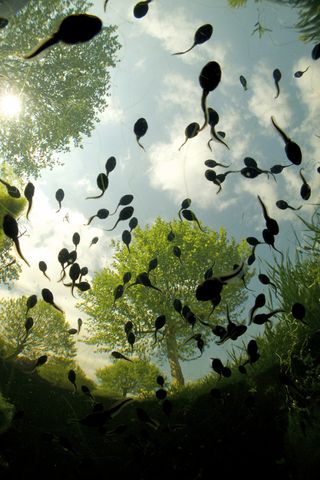
Overall winner Category winner: Ecology and Environmental Science
Tadpoles of many anuran species come in high numbers, but not many make it to adulthood. Here a group of common toad (Bufo bufo) tadpoles is seen from below. (Credit: Bert Willaert, Belgium.)
Ancestry. Dominance. Endangered.
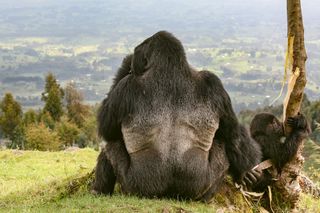
Runner up: Ecology and Environmental Science
This photo shows the strength and power of gorillas, one of our closest living relatives, yet also shows their vulnerability due to the pressures put on their world by humans. Taken in Rwanda, I observed the gorillas walking to the eucalyptus trees outside of the Volcanoes National Park and watched them strip the bark with their teeth. Within a few minutes, the silverback of the group sat down to eat bark and faced out towards the farmland — almost as if he was contemplating the human society that lives next to the gorillas' habitat. (Credit: Martha M. Robbins, Germany.)
Sign up for the Live Science daily newsletter now
Get the world’s most fascinating discoveries delivered straight to your inbox.
Caribbean brain coral
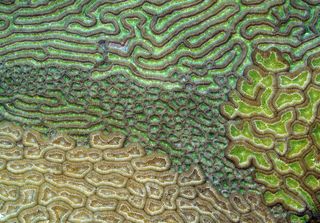
Special commendation: Proceedings B Publisher’s choice
The deep and abundant mysteries of reef building corals — their systematics, genetics, and phenotypic plasticity (variability in form possible within a single genetic individual) are only just now yielding their secrets to modern science. This image of what appears to be a single colony of the giant Caribbean brain coral Colpophyllia natans hints at the virtuoso abilities of corals to assume a wide range of different forms and appearances. This photo raises many important questions regarding this species of coral. Are the four distinct zones in this photograph really genetically identical? What spurred the colony to grow in this strange and beautiful manner? (Credit: Evan D'Alessandro, USA.)
Going with the flow: schooling to avoid a predator
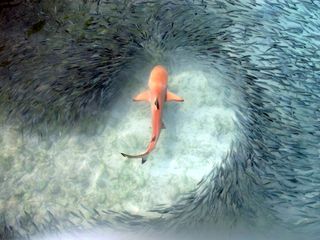
Category winner: Behaviour
A school of tropical clupeid fish exhibit synchronized behaviour to keep a healthy distance from a teenage black-tip reef shark. Sharks would cruise placidly for hours without so much as looking at the smaller fish, until, all of a sudden, they would strike and gobble up a mouthful of clupeids. The picture was taken on a shallow reef flat on Kuramathi Island in the Rasdhoo Atoll, Republic of Maldives. (Credit: Claudia Pogoreutz, Germany.)
Smashing
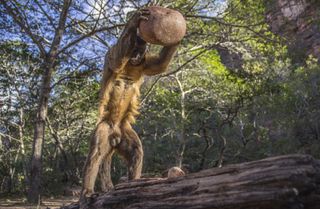
Runner up: Behaviour
An adult wild bearded capuchin monkey (Sapajus libidinosus) uses a stone tool to crack a very resistant palm nut in Fazenda Boa Vista (Piauì, Brazil). These monkeys habitually crack open very resistant palm nuts on hard surfaces using stones as percussive tools. This behaviour is considered one of the most complex forms of tool use by nonhuman species seen in nature. The alpha male, weighing 4.2 kg, picked up a big stone (3.5 kg) and lifted that above his head to crack a piassava nut. Capuchins’ actions are very fast so it is hard to capture the decisive moment. In a matter of milliseconds I shot and took the photo that I wanted: the representation of capuchin monkeys' strength and beauty. (Credit: Luca Antonio Marino, Italy.)
Sand has scales
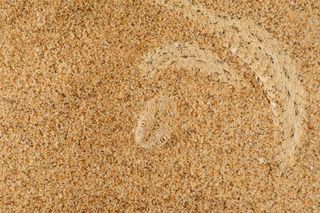
Runner up: Evolutionary Biology
Bitis peringueyi is an endemic adder from the Nabib desert. It's an ambush predator, highly equipped for the job. Many snakes are disguise masters but few completely burrow their entire body beneath the surface and fewer have their eyes located on the top of their head. Actually, if I hadn't blown off the sand to better show its scaly pattern, this adder would have been completely invisible. (Credit: Fabio Pupin, Italy.)
Fish louse
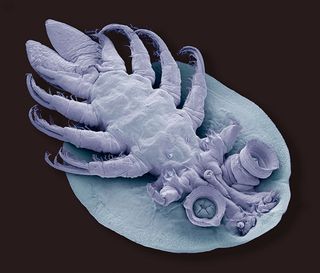
Special commendation
Lice lineages began to split and diversify during the late Cretaceous era, when dinosaurs, birds and early mammals probably were on the resilient parasites' menus. Argulus is a species of fish lice that has been shown to be a well-adapted parasite, exhibiting unique hunting and breeding strategies that enable it to live in the harsh and variable climates of Europe, East Asia and Siberia, wreaking havoc on the profitability of any freshwater fishery it inhabits and infests. (Credit: Steve Gschmeissner, UK.)
A baboon gets lost in his thoughts
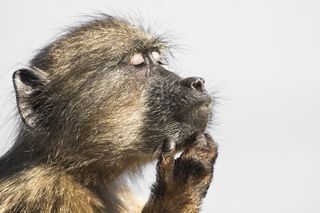
Special commendation
This image was taken at Cape Point Reserve, South Africa. I was taking photos of a group of baboons trying to capture some interesting action shots. The baboons were not very active as the sun was up and most of them were just resting. I noted this baboon sitting and facing the sun with his eyes closed, once I got close enough, without distracting him, he put one hand under his face, posing as though he was lost in his thoughts. (Credit: Davide Gaglio, South Africa.)
Fern with a drysuit
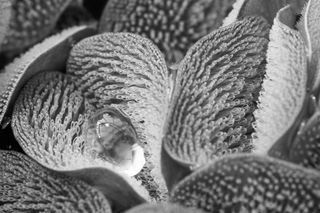
Category winner: Evolutionary Biology
Plants have evolved elaborate surface structures to modify the wettability of their leaves. The leaves of the water fern Salvinia molesta are covered with whisk-like hairs. The leaf surface and all but the very tip of the whisks is extremely water-repellent, keeping the leaf perfectly dry even when it is submerged for several weeks. The hydrophilic tips of the whisks 'pin' droplets in place. This further helps to prevent the water from entering the space in the between the whisks. In recent years, plant surfaces have repeatedly inspired the design of biomimetic ("nature-mimicking") applications for human use, most famously the self-cleaning paints based on the Lotus leaf. The photograph was taken in Bonn Botanic Garden (Germany). (Credit: Ulrike Bauer, UK.)
Runs at Dawn

Special commendation: Biology Letters publisher’s choice
In the Canary Islands of Lanzarote and Fuerteventura, after every winter rains Canarian Houbarabustard (Chlamydotis undulata) males begin their impressive courtship displays. From dawn onwards these males display at their favourite places and from there scamper around showing their plumage in all its glory. (Credit: Jose Juan Hernandez Martinez, Spain.)
Follow Elizabeth Palermo @techEpalermo. Follow Live Science @livescience, Facebook & Google+. Original article on Live Science.

Elizabeth is a former Live Science associate editor and current director of audience development at the Chamber of Commerce. She graduated with a bachelor of arts degree from George Washington University. Elizabeth has traveled throughout the Americas, studying political systems and indigenous cultures and teaching English to students of all ages.











